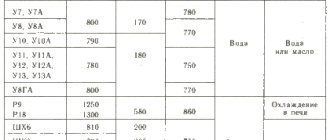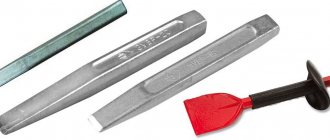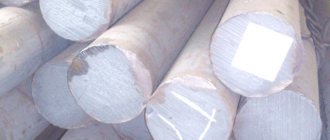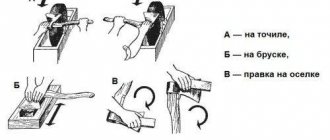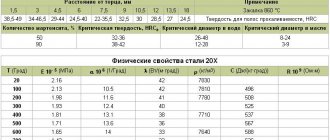Spring steel grades used in industry
Spring steel, grades of which are applicable in the manufacture of tight products, characterized by restoration of the original shape, with strong bending and significant twisting.
The most important parts in the production of mechanisms that experience variable, repeated loads, under the influence of which severe deformation occurs. As soon as the load stops, these elements return to their original shape. There is a feature in the operation of these parts that does not allow residual destruction; it must only be elastic. Excessive production requirements are placed on spring steels. Let's figure out what kind of steel springs are made of?
Production
Depending on further processing and the final type of part, steel is supplied in sheets, wire, hexagons, and squares. High performance qualities of the product are ensured by 2 components:
- the structure of the metal, which is determined by the chemical composition and subsequent processing;
- the presence of non-metallic inclusions in the structure, or rather the minimum quantity and size, which is eliminated at the stage of smelting and casting;
- the shape of the part (spiral, arc) and its dimensions, which is determined by the calculation method.
When the spring is stretched, the inner and outer sides of the coils experience different degrees of stress: the outer ones are less susceptible to stretching, while the inner ones experience the greatest degree of deformation. The same applies to the ends of the spring: they serve as attachment points, which increases the load in these and adjacent places. Therefore, steel grades have been developed that are preferably used for compression or tension.
Why is spring alloy produced?
Both alloy steel and carbon steel can be used to produce parts; they have increased elasticity, toughness, endurance and ductility. Due to the properties of these types of steel, elastic destruction is limited.
Spring steels are affordable, technologically advanced, and have a high limit of relaxation resistance.
Interesting: to obtain high-quality products from carbon and alloy steel, it is hardened at a temperature of 420-520 degrees, which produces the effect of a troostite structure.
Spring steels resist fragile fracture and are characterized by increased ductility. They are used to produce products with high wear resistance, for example:
- clamping collets;
- brake rolling;
- edges;
- springs and leaf springs;
- thrust washers;
- bearing torsos;
- friction discs;
- gears.
Steel grades according to GOST 14959–79
These are steels with a high carbon content, but with low alloying. Gosstandart 14959 means alloyed alloy of the following grades:
- 3K-7 - used in the production of cold-drawn wire, from which non-hardening springs are made;
- 50ХГ – produce springs for cars and springs for railways. compositions;
- 50HGA - purpose in production as in the previous brand of spring steel;
- 50HGFA – produce special springs and spring parts for cars;
- 50ХСА – special-purpose springs and small parts for watch mechanisms;
- 50HFA - they produce parts with increased load, with the requirements of the highest stability and strength, which operate at high temperatures - up to 300 degrees.
- 51HFA – for spring wire;
- 55С2 - for the production of spring mechanisms and springs used in tractor construction, mechanical engineering, for railway rolling stock;
- 55С2А – produces auto springs, springs for trains;
- 55S2GF - for the production of very strong springs of a special type, autosprings;
- 55KhGR – produce spring strip steel, the thickness of which varies from 3 to 24 mm;
- 60G - for the production of round and smooth springs, rings and other spring-type products with high wear resistance and elasticity, for example, staples, bushings, tambourines for braking systems used in heavy engineering;
Interesting: torsion steel, grade 60C2 - high-load springs, friction discs, spring washers;
- 60С2А - produce the same products as from the previous type of steel;
- 60S2G – type of spring steel from which tractor and auto springs are produced;
- 60С2Н2А – produce responsible springs with a high load on the alloy;
- 60С2ХА – for the production of highly loaded spring products subject to constant load;
- 60S2HFA is a round steel with calibration elements, from which springs and spring plates are produced with high responsibility;
- 65 – produce parts with increased strength and elasticity, which are operated under high pressure, high static loads and strong vibration;
- 65G - produce parts that will work without shock loads;
- 65GA – hardened wire for springs;
- spring steel grade - 65S2VA, highly loaded leaf springs and springs;
- 68A – hardened wire for the production of spring devices with a caliber of 1.2-5.5 mm;
- 70 – parts for mechanical engineering that require increased wear resistance;
- 70G – for spring elements;
- 70G2 - produce digging knives and springs for various industries;
- 70С2ХА – spring elements for watch devices and large springs for special purposes;
- 70С3А – springs with high load;
- spring steel grade 70HGFA – wire for the production of spring elements with heat treatment;
- 75 – any spring and other parts used in mechanical engineering that are subject to heavy vibration loads;
- 80 – for producing flat parts;
- 85 – wear-resistant parts;
- SH, SL, SM, DN, DM – machine springs operating under static loads;
- KT-2 – for the production of cold-drawn wire, which is wound without heat treatment.
Steel 60s2a spring
Stainless spring steel is cheap, has great elasticity, wear resistance, and does not have temper brittleness. This alloy does not deform under mechanical loads. It is used effectively at high humidity, as it has a stainless steel coating. It is used at a temperature of no more than 250 degrees, and is used for the production of rolled metal products.
Stainless steel is used to produce equipment in the marine industry, medicine, and food production. Its use in these industries is due to its corrosion-resistant alloy.
Interesting: stability is associated with a high content of molybdenum and chromium. The alloy has good resistance to cracking under heavy loads.
This grade of stainless, heat-resistant steel is used in the production of rolled thin sheets, seamless pipes and various tools for the food and chemical industries.
Four-sheet version 3153-2912010
A rear leaf spring of this type is mounted on UAZ models under the index: 3153, 3159, 3162. The part can be used on models 315148, 315143, Hunter, Patriot, 3163, 2362, Cargo. The modification in question is very popular among owners of cars from Ulyanovsk manufacturers.
Below are its main parameters:
- Control load, Pk, daN – 643.8.
- The weight of the assembled element is 21.4 kg.
- The total/calculated length of the part is 1.42/1.35 m.
- The height of the package is 49.6 millimeters.
- The number of sheets is four pieces.
- The material of manufacture is steel grade 5-HGFA.
Specifications of spring alloys
High- and medium-carbon types of these alloys are strengthened by fine cold destruction, allowing the introduction of shot blasting and water-abrasive methods. With this type of impact, residual compression forces are applied to the plane of the products.
In fact, any spring steel (non-corrosive, without special anti-corrosion properties) must undergo a high-heat operation using the through-hole method. Therefore, the finished metal product will have a troostite structure in its cut.
Oil hardening at a temperature of 830–880 degrees, combined with tempering at 410–480 degrees, guarantees an increase in the elasticity limit - the most important working property of the above steels. Isothermal hardening is often used, which provides not only high elasticity, but also increased plasticity, stability and viscosity of the substance.
Non-corrosive tape and wire made from alloys 70 and 65 are most often used to create machine springs. In the automotive industry, silicon spring steels of the spring rolling grade – 60С2А, 70С3А and 55С2 – are also dynamically used. They are prone to decarbonization, which reduces their elasticity and endurance characteristics. But due to the additives of chromium, vanadium and certain components, all these possible dangers are neutralized.
Areas of application for spring rolling of the most popular steel grades:
- springs for any devices and assemblies of the machine and automobile construction areas - 55S2, 50ХГ, 50ХГА;
- heavily loaded springs - 60 S2G, 60S2, 65S2VA, 60S2N2A;
- Wear-resistant springs are round and flat (a strip is used), operating at high vibrations - 80, 75.85.
In conclusion, a little about the disadvantages
- poor weldability;
- difficulty cutting.
Source of the article: https://solidiron.ru/steel/ressorno-pruzhinnye-stali-primenyaemye-v-promyshlennosti.html
Alloy and carbon materials
This type of material is used for the production of rigid (power) elastic elements. The reason for this particular application was that the high modulus of elasticity of this steel greatly limits the elastic deformation of the part that will be made from spring steel. It is also important to note that this type of product is high-tech and at the same time quite affordable. In addition to being used in automobile and tractor construction, this type of material is also widely used for the manufacture of power elements in various devices. Most often, parts made from this steel are called by one general name - general purpose spring steels.
In order to ensure the necessary performance of power elastic elements, it is necessary that spring steel have a high limit of not only elasticity, but also endurance, as well as relaxation resistance.
Basic information
Spring steel is an alloy that has a very high yield strength. Yield strength is a physical property of any material that characterizes the stress at which deformation continues to increase without increasing the load. In fact, this indicator reflects the ability of the material to maintain its shape when bending and twisting.
The better a material retains its shape during deformation, the higher its yield strength. A high yield strength occurs in the material due to special processing methods (hardening, tempering). This distinguishes spring steel from many other steel alloys, which usually “acquire unusual properties” due to the inclusion of various alloying additives in their composition.
In Russia, low-alloy alloys with a minimum amount of additional components are used for the production of spring steel. In American, European, and Asian countries, medium-carbon and high-carbon compounds containing chromium are also often used.
Compounds containing large amounts of manganese, nickel, silicon, tungsten, and nitrogen are also used. These components make the material even more plastic, and also increase its chemical inertness (that is, such a material will not react with alkalis, acids, and salts). As the name suggests, spring steel is commonly used to produce springs, torsion bars, leaf springs, piano strings, clamps and many other products.
Properties
In order to meet requirements such as endurance, elasticity and relaxation resistance, materials with a high carbon content are used. The percentage of this substance in the product used should be in the range from 0.5 to 0.7%. It is also important to quench and temper this type of steel. These procedures must be carried out at temperatures from 420 to 520 degrees Celsius.
It is worth noting that spring steel, hardened to martensite, has a low elasticity coefficient. It increases significantly only during tempering, when a troosite structure is formed. The process guarantees an increase in the ductility of steel, as well as its fracture toughness. These two factors are important in order to reduce sensitivity to stress risers, as well as increase the endurance limit of the product. It can be added that isometric hardening to lower bainite is also characterized by positive qualities.
Spring steel for a knife has been the most common material for some time, especially among car owners. The production of sharp objects was indeed carried out from old springs that had become unusable for use in a vehicle. Knives made from such an unusual material were used both for various household needs and for ordinary cutting of food in the kitchen. The choice of this particular detail did not fall by chance. There were several reasons why spring steel became the main material for the homemade production of good knives.
The first reason is that due to the poor quality of roads, such a part as a spring often and quickly became unusable. Because of this, many car owners had an abundance of these units. The parts were just lying in garages. Availability was the first reason.
The second reason is the spring design, which included several sheets of carbon steel. It was from these elements that it was possible to make a pair of good knives.
The third reason is the high elasticity of spring steel, which allows processing of the material with only a minimal set of tools.
Standard UAZ spring type 3163-2912010-02
This standard low-leaf element has the following characteristics:
- Ultimate load, Pk, daN – 504.7.
- The weight of the assembled part is 17.3 kg.
- The total length is 1.42 meters.
- The height of the package is 37.2 mm.
- The number of sheets is three pieces.
- Manufacturing material – steel type 50HGFA.
The UAZ Patriot springs in question are also suitable for models 315148, 315143, 315196, Hunter, Simbir and Cargo. This part differs from its analogue 315112-2912012 in length and tightening clamp, as well as the presence of gaskets between the sheets.
Features of knives
A significant reason why this particular type of steel has become widely used for the production of knives is the composition of the product itself. In production, this composition was called spring steel 65G. As the name suggests, this material is widely used for the production of leaf springs, springs, washers, and some other parts. The cost of this particular grade of steel is considered one of the lowest among carbon materials. But at the same time, its characteristics, that is, strength, flexibility and impact strength, are at their best. In addition, the hardness of the steel itself has also increased. All these features of carbon metal also played a decisive role in the choice of material for creating knives.
Model 31512-2912012
This UAZ spring is a rear small-leaf part, which in the standard version was mounted on models 31512, 31514-10, 3160. The element is also suitable for “Patriots” and “Hunters”, as well as their modifications.
Distinctive characteristics of the node in question:
- Control load – 504.7 daN.
- The weight of the assembled unit is 16.5 kilograms.
- Element length – 1.35 m.
- The number of sheets is three pieces.
- The height of the package is 37.2 mm.
- Material grade – steel 50Х-ГФА.
Steel 65G
Spring steel 65G is a structural high-carbon steel, which is supplied in accordance with GOST 14959. This grade belongs to the group of spring steels. The two most important requirements for this type of steel are high surface strength and increased elasticity. In order to achieve the required strength, up to 1% manganese is added to the metal composition. In addition, in order to achieve all the required indicators, it is necessary to carry out proper heat treatment of parts made from this grade.
Heat treatment
There are several heat treatment modes for this type of steel. Any of them is selected in accordance with the production requirements for the finished product. Most often, two heat treatment methods are used, which guarantee the required properties from a chemical and physical point of view. These methods include normalization and hardening followed by tempering.
When carrying out heat treatment, it is necessary to correctly select the temperature parameters, as well as the time needed to carry out the operation. To choose these characteristics correctly, you should start from what grade of steel is used. Since the material of grade 65G belongs to the hypoeutectide type, this product contains austenite, presented in the form of a solid mechanical mixture with a small amount of ferrite. Austenite is a harder material in terms of structure than ferrite. Therefore, to carry out heat treatment of 65G steel, it is necessary to create a lower quenching temperature range. Taking this fact into account, similar indicators for this type of metal range from 800 to 830 degrees Celsius.
UAZ spring mounting
Installing a reinforced spring is not too difficult. The work is performed in the following order:
- First, the rear of the car is raised until the wheels begin to hang down. A safety beam or support must be installed.
- Then the wheel is removed.
- An additional support under the bridge is being installed. A standard jack is quite suitable for this.
- The stepladders and cups of the block are unscrewed.
- The shock-absorbing element is removed from the lower mount.
- The bridge is lowering.
- The old spring is dismantled.
- A new element is being tried on.
- The bridge is lowered to the optimal point for installing a new part.
- The element is placed in bowls located on the frame, the hanging part is supported by a wooden block, which will not allow the spring to jump out until final installation.
- The prepared new unit is mounted, secured with stepladders, but not yet tightened until it stops.
- The bowls are placed at the previous installation location.
- The bridge is raised until the springs settle on the cushions.
- The wheel is beaded.
- The lower cups are twisted.
At this point, the repair of the UAZ in terms of replacing springs can be considered ready. To ensure that the installed part fits better in its place, it is advisable to load the rear of the car when working. After carrying out the work, check the car in action at low speed. If there is no discomfort or squeaking, the modernization was successful.
Quenching mode
How to harden spring steel? It is necessary to create the desired temperature regime, select the correct time, and also correctly calculate the time and temperature of the vacation. In order to give the steel all the necessary characteristics that are set by the future technical conditions of the part, it is worth carrying out the necessary hardening. To select the appropriate mode for this procedure, rely on the following characteristics:
- Not only the hardening method is important, but also the equipment used to heat the steel.
- Select the required hardening temperature.
- Select a suitable time period for hardening steel.
- Select the desired environment for the hardening process.
- It is also important to choose the right technology for cooling the part after the hardening process.
Spring steel grades
Steel for the manufacture of springs is supplied in the form of strips. After this, blanks are cut from it, hardened, tempered and collected in the form of bags. Brands of spring steel, such as 65, 70, 75, 80, etc., are characterized by the fact that their relaxation resistance is low, this disadvantage is especially noticeable when the part is heated. These steel grades cannot be used for work in environments whose temperatures exceed 100 degrees Celsius.
There are cheap silicon grades 55C2, 60C2, 70SZA. They are used to make springs or leaf springs, the thickness of which will not exceed 18 mm.
Higher quality steel grades include 50HFA, 50HGFA. If we compare it with silicon-manganese and silicon materials, then during tempering the temperature is much higher - about 520 degrees. Due to this processing procedure, these steel grades are characterized by high heat resistance, as well as low sensitivity to notching.
Source of the article: https://fb.ru/article/336776/ressornaya-stal-opisanie-harakteristiki-marka-i-otzyivyi
Modification 3162-2912010
This UAZ spring is a standard part that is mounted on the rear axle of almost all cars of this brand, including Patriot, Bars, Hunter and Cargo. This spring is quite rare on sale, and therefore is not particularly popular among owners.
- Ultimate load, Pk, daN – 643.75.
- Weight when assembled: 21.4 kg.
- The total/calculated length of the part is 1.42/1.35 m.
- The height of the package is 49.6 mm.
- Number of sheets – four pcs.
- Manufacturing material – steel 50HGFA.
